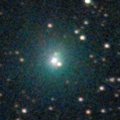
|
Now it is bright as 10.1 mag (Sept. 6, Maik Meyer). It will brighten up to 8-9 mag in autumn. It moves southwards very rapidly after this. In the Southern Hemisphere, it becomes observable in excellent condition after this. In the Northern Hemisphere, it will be getting lower after this, and it will be unobservable in November.
Date(TT) R.A. (2000) Decl. Delta r Elong. m1 Best Time(A, h)
Sept. 7 2 42.18 52 18.6 0.821 1.455 104 9.6 3:42 (180, 72)
Sept.14 1 50.53 45 43.9 0.659 1.459 121 9.1 2:24 (180, 79)
|
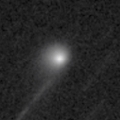
|
Now it is 11.6 mag (Sept. 6, Maik Meyer). It stays bright as 11 mag until winter. It stays observable in good condition for a long time in the Northern Hemisphere. In the Southern Hemisphere, it will be getting lower gradually, and it will be unobservable in early December.
Date(TT) R.A. (2000) Decl. Delta r Elong. m1 Best Time(A, h)
Sept. 7 2 28.66 25 14.6 2.557 3.188 120 11.6 3:27 ( 0, 80)
Sept.14 2 20.86 27 18.7 2.460 3.175 127 11.5 2:52 ( 0, 82)
|
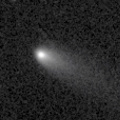
|
Now it is 12.3 mag (Sept. 6, Maik Meyer). It stays 12 mag until November. It is observable in excellent condition in the Northern Hemisphere. It will be extremely low after October in the Southern Hemisphere.
Date(TT) R.A. (2000) Decl. Delta r Elong. m1 Best Time(A, h)
Sept. 7 2 27.56 24 52.5 0.606 1.417 120 11.8 3:26 ( 0, 80)
Sept.14 2 36.66 29 14.2 0.586 1.417 123 11.7 3:07 ( 0, 84)
|

|
It has not been observed yet in this apparition. Now it is fainter than 21.5 mag (Aug. 4, Erwin Schwab). It was expected to brighten up to 12 mag from August to September. But actually, it must be much fainter than expected. It is observable in good condition in the Northern Hemisphere. In the Southern Hemisphere, it will be unobservable in September.
Date(TT) R.A. (2000) Decl. Delta r Elong. m1 Best Time(A, h)
Sept. 7 5 13.04 40 43.7 1.109 1.411 83 11.9 4:09 (248, 65)
Sept.14 5 35.27 43 19.3 1.101 1.435 85 12.0 4:16 (240, 67)
|
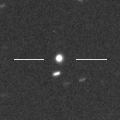
|
Now it is 12.3 mag (Sept. 6, Maik Meyer). It is expected to brighten up to 8 mag in 2020. It stays observable in good condition for a long time in the Northern Hemisphere. In the Southern Hemisphere, it will be getting lower gradually, and it will be unobservable in early December.
Date(TT) R.A. (2000) Decl. Delta r Elong. m1 Best Time(A, h)
Sept. 7 5 24.04 23 31.3 3.371 3.383 82 12.7 4:09 (283, 59)
Sept.14 5 28.54 24 33.5 3.198 3.316 87 12.5 4:16 (288, 65)
|

|
It brightened rapidly. Now it is very bright as 11.5 mag (Sept. 3, Chris Wyatt). It may fade out rapidly after this. In the Southern Hemisphere, it stays observable in the low sky until it becomes fainter than 18 mag in winter. It is not observable at all in the Northern Hemisphere.
Date(TT) R.A. (2000) Decl. Delta r Elong. m1 Best Time(A, h)
Sept. 7 9 32.35 -43 12.7 1.917 1.546 53 12.7 4:09 (306,-26)
Sept.14 10 3.67 -48 12.1 1.933 1.586 54 13.0 4:16 (311,-28)
|
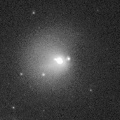
|
Now it is 14.7 mag (Sept. 5, Chris Wyatt).
Date(TT) R.A. (2000) Decl. Delta r Elong. m1 Best Time(A, h)
Sept. 7 0 54.92 16 17.9 4.930 5.773 143 13.2 1:54 ( 0, 71)
Sept.14 0 52.32 16 12.2 4.875 5.774 150 13.2 1:23 ( 0, 71)
|
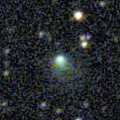
|
Now it is 13.3 mag (Aug. 28, Chris Wyatt). It is observable at 13.5 mag in good condition in autumn.
Date(TT) R.A. (2000) Decl. Delta r Elong. m1 Best Time(A, h)
Sept. 7 17 40.56 -10 44.1 1.436 1.905 100 13.8 19:45 ( 23, 41)
Sept.14 17 50.70 -11 44.2 1.475 1.883 96 13.8 19:34 ( 24, 40)
|

|
Appearing in the morning sky. It is observable at 14 mag in good condition in autumn.
Date(TT) R.A. (2000) Decl. Delta r Elong. m1 Best Time(A, h)
Sept. 7 8 1.05 15 43.3 2.976 2.371 44 13.9 4:09 (267, 23)
Sept.14 8 13.04 14 55.7 2.941 2.399 48 13.9 4:16 (270, 27)
|

|
Now it is 13.9 mag (Sept. 5, Chris Wyatt). It stays 13-14 mag for a long time in 2019. In the Southern Hemisphere, it is observable in good condition. In the Northern Hemisphere, it is not observasble until summer in 2020.
Date(TT) R.A. (2000) Decl. Delta r Elong. m1 Best Time(A, h)
Sept. 7 9 12.36 -70 2.6 3.092 3.056 78 13.9 4:09 (336,-33)
Sept.14 9 27.27 -72 44.9 3.101 3.067 78 14.0 4:16 (340,-32)
|

|
It brightened up to 7.7 mag in June in 2018 (June 19, Juan Jose Gonzalez). Now it is fading. It has already faded down to 14.3 mag (Aug. 24, Thomas Lehmann). In the Southern Hemisphere, it stays observable for a long time until the comet will fade out. In the Northern Hemisphere, it will appear in the morning sky in late September. But it stays low for a while after that.
Date(TT) R.A. (2000) Decl. Delta r Elong. m1 Best Time(A, h)
Sept. 7 7 1.02 -29 50.1 4.972 4.685 67 14.4 4:09 (313, 6)
Sept.14 7 2.88 -30 17.3 4.970 4.742 71 14.4 4:16 (318, 10)
|

|
It passed only 0.05 a.u. from Sun on Aug. 31. It was not observable on the ground. But it was detected in the SOHO spacecraft's images.
Date(TT) R.A. (2000) Decl. Delta r Elong. m1 Best Time(A, h)
Sept. 7 11 17.48 3 54.4 1.326 0.333 4 14.5 19:45 (106,-16)
Sept.14 11 54.56 -1 14.7 1.534 0.561 8 17.2 19:34 ( 99,-15)
|
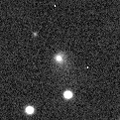
|
Now it is 14.0 mag (Sept. 5, Chris Wyatt). In the Southern Hemisphere, it is observable for a long time. It stays low in the Northern Hemisphere.
Date(TT) R.A. (2000) Decl. Delta r Elong. m1 Best Time(A, h)
Sept. 7 23 40.58 -45 20.7 3.521 4.342 140 14.8 0:40 ( 0, 10)
Sept.14 23 32.29 -44 46.0 3.559 4.368 138 14.9 0:04 ( 0, 10)
|
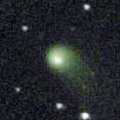
|
Now it is 14.8 mag (Aug. 28, Chris Wyatt). It will be fading slowly after this. In the Southern Hemisphere, it stays observable in good condition for a long time, although it becomes low from October to November. It will never be observable after this in the Northern Hemisphere.
Date(TT) R.A. (2000) Decl. Delta r Elong. m1 Best Time(A, h)
Sept. 7 13 36.83 -43 47.2 4.296 3.913 61 15.1 19:45 ( 47,-16)
Sept.14 13 39.11 -44 19.2 4.413 3.948 56 15.2 19:34 ( 48,-19)
|
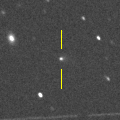
|
Now it is 17.5 mag (Aug. 26, Toshihiko Ikemura, Hirohisa Sato). It will brighten up to 15.5 mag and it will be observable in good condition in autumn.
Date(TT) R.A. (2000) Decl. Delta r Elong. m1 Best Time(A, h)
Sept. 7 0 3.25 -7 3.8 1.601 2.586 164 16.0 1:02 ( 0, 48)
Sept.14 0 0.18 -7 40.4 1.564 2.562 170 15.9 0:32 ( 0, 47)
|
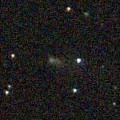
|
Now it is 16.7 mag (Sept. 1, Toshihiko Ikemura, Hirohisa Sato). It is observable at 16 mag in good condition from summer to autumn. It locates somewhat low in the Southern Hemisphere.
Date(TT) R.A. (2000) Decl. Delta r Elong. m1 Best Time(A, h)
Sept. 7 3 34.51 27 24.0 1.598 2.109 105 15.9 4:09 (325, 81)
Sept.14 3 40.37 27 59.6 1.545 2.125 111 15.9 4:11 ( 0, 83)
|
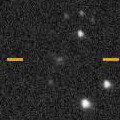
|
Now it is 15.0 mag (July 21, iTelescope Observatory, Siding Spring). It stays 16 mag for a long time from 2019 to 2020. It stays observable for a long time in the Southern Hemisphere. It is hardly observable in the Northern Hemisphere.
Date(TT) R.A. (2000) Decl. Delta r Elong. m1 Best Time(A, h)
Sept. 7 11 23.33 -57 30.1 3.859 3.535 64 15.9 19:45 ( 41,-40)
Sept.14 11 29.76 -58 44.9 3.871 3.521 62 15.9 19:34 ( 39,-42)
|
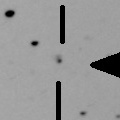
|
It looks cometary on the LCO (CTIO) image on Aug. 21. Now it is 15.9 mag (Aug. 8, ATLAS-MLO, Mauna Loa). It is observable in excellent condition in the Southern Hemisphere. In the Northern Hemisphere, it locates extremely low for a while.
Date(TT) R.A. (2000) Decl. Delta r Elong. m1 Best Time(A, h)
Sept. 7 20 23.38 -42 36.4 5.724 6.417 129 16.0 21:18 ( 0, 12)
Sept.14 20 15.63 -42 12.9 5.815 6.417 122 16.0 20:43 ( 0, 13)
|
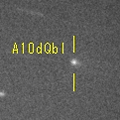
|
Now it is 15.8 mag (Aug. 26, Toshihiko Ikemura, Hirohisa Sato). It stays observable in good condition while the comet will be fading slowly after this.
Date(TT) R.A. (2000) Decl. Delta r Elong. m1 Best Time(A, h)
Sept. 7 3 22.19 8 0.4 1.629 2.228 113 16.0 4:09 (354, 63)
Sept.14 3 27.44 7 3.2 1.600 2.262 118 16.1 3:58 ( 0, 62)
|
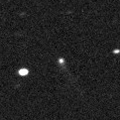
|
Now it is 16.0 mag (Sept. 1, Toshihiko Ikemura, Hirohisa Sato). It stays 15-16 mag for a long time until 2021.
Date(TT) R.A. (2000) Decl. Delta r Elong. m1 Best Time(A, h)
Sept. 7 20 34.95 -32 13.9 4.237 5.025 137 16.1 21:30 ( 0, 23)
Sept.14 20 27.33 -31 25.6 4.296 5.000 129 16.2 20:55 ( 0, 24)
|
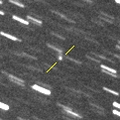
|
Now it is 16.5 mag (July 27, Kevin Hills). It will brighten up to 14 mag in winter. It stays observable for a long time in the Southern Hemisphere, although it becomes low in November. In the Northern Hemisphere, it is not observable for a long time until August in 2020.
Date(TT) R.A. (2000) Decl. Delta r Elong. m1 Best Time(A, h)
Sept. 7 14 52.83 -39 34.8 2.913 2.746 70 16.2 19:45 ( 41, -3)
Sept.14 14 53.76 -40 32.5 2.962 2.693 64 16.2 19:34 ( 43, -5)
|
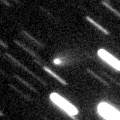
|
Peculiar asteroid moving along a cometary orbit. Now it is bright as 16.6 mag (Aug. 29, Roberto Haver and Roberto Gorelli). Roberto Haver reported its cometary activity was detected. It is observable at 15.5 mag in good condition in autumn.
Date(TT) R.A. (2000) Decl. Delta r Elong. m1 Best Time(A, h)
Sept. 7 6 7.14 22 26.7 2.525 2.415 72 16.3 4:09 (276, 50)
Sept.14 6 0.22 21 31.8 2.374 2.423 80 16.2 4:16 (285, 57)
|

|
First return of a new periodic comet which brightened up to 16.5 mag in 2009. It has not been recovered yet in this apparition. It will brighten up to 16 mag in autumn. It is observable in good condition in the Northern Hemisphere. It locates low in the Southern Hemisphere.
Date(TT) R.A. (2000) Decl. Delta r Elong. m1 Best Time(A, h)
Sept. 7 6 58.07 25 35.0 1.406 1.269 60 16.3 4:09 (265, 41)
Sept.14 7 25.51 23 58.1 1.397 1.269 61 16.3 4:16 (268, 42)
|
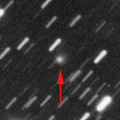
|
Now it is 16.3 mag (Sept. 1, Toshihiko Ikemura, Hirohisa Sato). It is expected to be observable at 5-6 mag for a long time from 2022 to 2023. In the Northern Hemisphere, it is not observable at the highlight from 2022 summer to 2023 summer. In the Southern Hemisphere, it stays unobservable for a while. But it will be observable in good condition at the highlight.
Date(TT) R.A. (2000) Decl. Delta r Elong. m1 Best Time(A, h)
Sept. 7 17 6.96 53 13.3 10.939 10.913 85 16.6 19:45 (143, 64)
Sept.14 17 6.95 52 30.4 10.921 10.866 84 16.6 19:34 (139, 63)
|

|
Fading now. Now it is 15.7 mag (Aug. 5, M. Masek). In the Southern Hemisphere, it stays observable for a long time until it fades out. In the Northern Hemisphere, it will not be observable after this.
Date(TT) R.A. (2000) Decl. Delta r Elong. m1 Best Time(A, h)
Sept. 7 6 45.07 -35 51.2 5.070 4.873 73 16.7 4:09 (319, 3)
Sept.14 6 45.73 -37 34.0 5.060 4.925 76 16.7 4:16 (326, 6)
|

|
It approached to Earth down to 0.3 a.u. in mid February, and brightened up to 5.5 mag (Feb. 13, Juan Jose Gonzalez). Now it is fading. It has already faded down to 16.9 mag (Aug. 23, Thomas Lehmann).
Date(TT) R.A. (2000) Decl. Delta r Elong. m1 Best Time(A, h)
Sept. 7 4 9.90 42 34.9 2.862 3.114 94 16.7 4:09 (232, 76)
Sept.14 3 57.72 43 3.5 2.803 3.187 103 16.8 4:16 (197, 81)
|
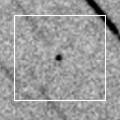
|
It passed the perihelion on July 2. Then it must have brightened up to 13 mag, but it was not observable around that time. In the Northern Hemisphere, it stays observable in excellent condition until December when it becomes fainter than 18 mag. In the Southern Hemisphere, it stays locating low.
Date(TT) R.A. (2000) Decl. Delta r Elong. m1 Best Time(A, h)
Sept. 7 4 35.69 50 51.5 0.978 1.391 88 16.7 4:09 (218, 68)
Sept.14 4 17.84 52 22.4 0.959 1.475 97 16.7 4:16 (197, 72)
|
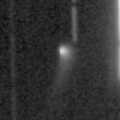
|
Now it is 16.8 mag (Aug. 2, Charles Morris). It will be fading after this. In the Northern Hemisphere, it stays observable in good condition for a long time. In the Southern Hemisphere, it stays extremely low for a long time.
Date(TT) R.A. (2000) Decl. Delta r Elong. m1 Best Time(A, h)
Sept. 7 3 56.33 49 59.6 3.729 3.951 95 16.8 4:09 (206, 73)
Sept.14 3 46.29 49 59.6 3.642 3.986 102 16.8 4:16 (181, 75)
|
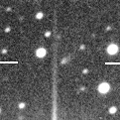
|
Now it is 16.6 mag (Sept. 2, Toshihiko Ikemura, Hirohisa Sato). It is observable at 17 mag in good condition from August to September. It will be fainter than 18 mag in November.
Date(TT) R.A. (2000) Decl. Delta r Elong. m1 Best Time(A, h)
Sept. 7 0 33.65 17 15.8 1.539 2.446 147 16.8 1:33 ( 0, 73)
Sept.14 0 18.93 11 54.8 1.510 2.478 159 16.8 0:51 ( 0, 67)
|

|
Now it is 18.4 mag (Aug. 1, iTelescope Observatory, Siding Spring). It will brighten up to 16 mag in autumn. It is observable in good condition in the Southern Hemisphere. It locates somewhat low in the Northern Hemisphere.
Date(TT) R.A. (2000) Decl. Delta r Elong. m1 Best Time(A, h)
Sept. 7 18 33.30 -34 11.4 1.331 1.956 112 16.9 19:45 ( 4, 21)
Sept.14 18 40.15 -32 36.3 1.371 1.931 107 16.8 19:34 ( 6, 22)
|
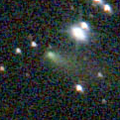
|
It brightened up to 13.0 mag in May (May 15, Thomas Lehmann). Now it is fading. It has already faded down to 17.6 mag (Sept. 1, Toshihiko Ikemura, Hirohisa Sato). It is observable in excellent condition in the Northern Hemisphere. It locates extremely low in the Southern Hemisphere.
Date(TT) R.A. (2000) Decl. Delta r Elong. m1 Best Time(A, h)
Sept. 7 1 9.74 45 28.8 1.524 2.214 120 17.3 2:08 (180, 79)
Sept.14 1 6.24 44 20.8 1.525 2.276 126 17.6 1:38 (180, 80)
|

|
Now it is 19.4 mag (Aug. 14, Slooh.com Canary Islands Observatory). It is predicted to brighten up to 16.5 mag in winter, and it will be observable in good condition. But it is fainter than this ephemeris recently. It locates somewhat low in the Southern Hemisphere.
Date(TT) R.A. (2000) Decl. Delta r Elong. m1 Best Time(A, h)
Sept. 7 4 23.92 24 25.0 3.088 3.341 95 17.5 4:09 (299, 71)
Sept.14 4 28.33 24 37.8 2.983 3.330 101 17.4 4:16 (315, 76)
|

|
Now it is 18.3 mag (Aug. 23, A. Diepvens). It will brighten very rapidly, and it will brighten up to 14 mag in winter. It is observable in excellent condition in the Northern Hemisphere. It locates low in the Southern Hemisphere.
Date(TT) R.A. (2000) Decl. Delta r Elong. m1 Best Time(A, h)
Sept. 7 2 9.02 41 18.6 1.366 2.020 115 17.8 3:07 (180, 84)
Sept.14 2 14.67 42 47.0 1.277 1.981 119 17.5 2:45 (180, 82)
|
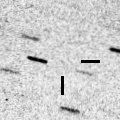
|
Peculiar asteroid moving along a cometary orbit. It approached to Earth down to 0.37 a.u. in mid August. Then it brightened up to 14.8 mag (Aug. 19, P. Camilleri, J. Oey, R. Groom). Now it is fading very rapidly.
Date(TT) R.A. (2000) Decl. Delta r Elong. m1 Best Time(A, h)
Sept. 7 17 8.75 -22 4.1 0.810 1.340 94 17.5 19:45 ( 27, 28)
Sept.14 16 46.46 -19 35.2 1.037 1.342 82 18.0 19:34 ( 37, 26)
|
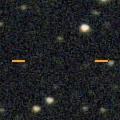
|
It was observed at 18 mag in summer in 2018. In 2019, it is predicted to brighten up to 17.5 mag, and it is be observable in good condition in autumn. But actually, it is not detected, fainter than 19.5 mag (Aug. 29, Roland Fichtl).
Date(TT) R.A. (2000) Decl. Delta r Elong. m1 Best Time(A, h)
Sept. 7 1 36.55 20 33.1 2.532 3.305 133 17.6 2:35 ( 0, 76)
Sept.14 1 35.11 20 22.0 2.472 3.307 140 17.5 2:06 ( 0, 75)
|

|
First return of a new periodic comet which brightened up to 18 mag in 2014. Now it is 20.0 mag (July 27, iTelescope Observatory, Siding Spring). It will brighten rapidly up to 17 mag in autumn. It is observable in good condition in the Northern Hemisphere. It locates extremely low in the Southern Hemisphere.
Date(TT) R.A. (2000) Decl. Delta r Elong. m1 Best Time(A, h)
Sept. 7 2 43.30 17 14.2 0.316 1.198 120 17.9 3:41 ( 0, 72)
Sept.14 3 20.09 23 15.6 0.295 1.169 116 17.6 3:50 ( 0, 78)
|

|
Now it is 19.7 mag (Aug. 30, Jean-Francois Soulier). It brightens up to 16.5 mag from October to December. It is observable in good condition in the Northern Hemisphere. It locates low in the Southern Hemisphere.
Date(TT) R.A. (2000) Decl. Delta r Elong. m1 Best Time(A, h)
Sept. 7 6 17.21 9 42.9 1.727 1.677 70 17.8 4:09 (289, 41)
Sept.14 6 34.34 10 54.4 1.656 1.658 72 17.6 4:16 (292, 45)
|

|
Now it is fading. In 2019, it is observable at 17.5 mag in good condition in autumn.
Date(TT) R.A. (2000) Decl. Delta r Elong. m1 Best Time(A, h)
Sept. 7 2 56.74 11 17.3 3.518 4.097 118 17.7 3:55 ( 0, 66)
Sept.14 2 55.83 11 13.1 3.443 4.112 125 17.7 3:27 ( 0, 66)
|
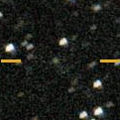
|
Now it is 17.5 mag (Sept. 1, Toshihiko Ikemura, Hirohisa Sato). It will brighten up to 12 mag in winter in 2022.
Date(TT) R.A. (2000) Decl. Delta r Elong. m1 Best Time(A, h)
Sept. 7 22 23.33 47 38.1 7.265 7.892 125 17.8 23:18 (180, 77)
Sept.14 22 19.47 47 32.0 7.204 7.847 126 17.7 22:46 (180, 77)
|

|
First return of a new periodic comet which brightened up to 17 mag in 2006. It has not been recovered yet in this apparition. It will brighten up to 18 mag in autumn. It is observable in good condition in the Southern Hemisphere. It locates extremely low in the Northern Hemisphere.
Date(TT) R.A. (2000) Decl. Delta r Elong. m1 Best Time(A, h)
Sept. 7 16 53.55 -36 40.2 2.289 2.540 92 17.9 19:45 ( 23, 13)
Sept.14 17 3.65 -36 18.6 2.353 2.523 87 17.9 19:34 ( 25, 13)
|

|
Now it is bright as 17 mag (Aug. 23, Hidetaka Sato). Hidetaka Sato reported it looks cometary with coma. It will be getting lower gradually after this.
Date(TT) R.A. (2000) Decl. Delta r Elong. m1 Best Time(A, h)
Sept. 7 17 51.54 -11 8.6 4.274 4.618 103 19.6 19:45 ( 19, 42)
Sept.14 17 53.50 -11 28.3 4.374 4.615 97 19.7 19:34 ( 24, 40)
|
|
![]()
 C/2017 T2 ( PanSTARRS )
C/2017 T2 ( PanSTARRS ) C/2019 A9 ( PanSTARRS )
C/2019 A9 ( PanSTARRS ) 29P/Schwassmann-Wachmann 1
29P/Schwassmann-Wachmann 1 68P/Klemola
68P/Klemola 78P/Gehrels 2
78P/Gehrels 2 C/2018 A6 ( Gibbs )
C/2018 A6 ( Gibbs ) C/2016 M1 ( PanSTARRS )
C/2016 M1 ( PanSTARRS ) 322P/SOHO
322P/SOHO C/2017 B3 ( LINEAR )
C/2017 B3 ( LINEAR ) C/2017 M4 ( ATLAS )
C/2017 M4 ( ATLAS ) 101P/Chernykh
101P/Chernykh 261P/Larson
261P/Larson C/2018 F4 ( PanSTARRS )
C/2018 F4 ( PanSTARRS ) A/2017 U7
A/2017 U7 C/2019 K5 ( Young )
C/2019 K5 ( Young ) C/2019 K7 ( Smith )
C/2019 K7 ( Smith ) C/2019 K1 ( ATLAS )
C/2019 K1 ( ATLAS ) 2018 DO4
2018 DO4 P/2008 Y1 ( Boattini )
P/2008 Y1 ( Boattini ) C/2017 K2 ( PanSTARRS )
C/2017 K2 ( PanSTARRS ) C/2016 N6 ( PanSTARRS )
C/2016 N6 ( PanSTARRS ) C/2018 Y1 ( Iwamoto )
C/2018 Y1 ( Iwamoto ) (3200) Phaethon
(3200) Phaethon C/2018 A3 ( ATLAS )
C/2018 A3 ( ATLAS ) C/2019 K4 ( Ye )
C/2019 K4 ( Ye ) 160P/LINEAR
160P/LINEAR C/2019 D1 ( Flewelling )
C/2019 D1 ( Flewelling ) 203P/Korlevic
203P/Korlevic 114P/Wiseman-Skiff
114P/Wiseman-Skiff A/2018 V3
A/2018 V3 200P/Larsen
200P/Larsen P/2019 O1 ( Kowalski )
P/2019 O1 ( Kowalski ) 76P/West-Kohoutek-Ikemura
76P/West-Kohoutek-Ikemura 65P/Gunn
65P/Gunn C/2019 L3 ( ATLAS )
C/2019 L3 ( ATLAS ) P/2006 H1 ( McNaught )
P/2006 H1 ( McNaught ) 2019 LD2
2019 LD2![]()





























